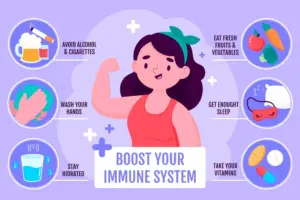Heart Attack – Early Warning Signs & Emergency Care
A heart attack, or myocardial infarction, happens when blood flow to the heart is interrupted, usually because of plaque — a pileup of fatty deposits — in the arteries. This blockage is one potential cause of heart damage that can lead to heart attacks and potentially fatal complications unless immediate steps are taken to rectify it.
Early recognition of heart attack symptoms is critical. Most people ignore those early warning signs thinking they are just slight irritations. But swift action can make the difference between life and death. Knowing the risk factors, symptoms, and preventive measures helps individuals take proactive steps towards keeping their heart healthy.
Heart disease continues to be a leading cause of death in the UK, which is why, awareness and education are vital. In this blog, we will discuss heart attack symptoms, their causes and how we can prevent heart attacks.
Recognising the Warning Signs
A heart attack can manifest in many different ways, and symptoms are not the same for everyone. But some warning signs can be generalised, including:
- Chest pain or discomfort: A feeling of pressure, squeezing, or fullness in the chest. The episode could last a few minutes or be intermittent.
- Shortness of breath: You may experience difficulty breathing with or without chest pain.
- Pain in other parts of the body: A heart attack can also cause pain in the arms, back, neck, jaw, or stomach.
- Nausea, dizziness, or cold sweats: Some people may feel lightheaded, break out in a sweat, or feel nauseous.
Heart attack symptoms vary from person to person, so it is important to recognise them. For some, it can be extremely painful, and for others, only mildly uncomfortable. Sometimes, symptoms can be so mild they are confused with other ailments, such as indigestion.
Signs and Symptoms of Women’s Heart Attack
Symptoms of a heart attack may be different in women as compared to common symptoms seen in men. Women may have more subtle symptoms, which can delay diagnosis and treatment. Some key symptoms include:
- Excessive fatigue: Extreme tiredness, more than what is normal without significant exertion.
- Indigestion-like discomfort: A burning sensation in the chest or upper abdomen, which is commonly mistaken for acid reflux.
- Pain in the lower chest or upper abdomen: Rather than the classic crushing chest pain, a woman may feel discomfort lower in the chest or in the stomach area.
These symptoms are non-specific and tend to be less pronounced, so many women shrug them off. But ignoring these signals can lead to serious consequences. Any of these symptoms should prompt immediate medical attention.
What Causes a Heart Attack?
Coronary artery disease (CAD), in which plaque builds up in the coronary arteries and limits blood flow to the heart, is the leading cause of a heart attack. Other causes include:
- Formation of blood clots: Plaque can rupture, causing a clot to form that blocks blood flow.
- Coronary artery spasms: Sudden constriction of the arteries can restrict blood flow to the heart.
Several risk factors make a heart attack more likely, from high cholesterol and high blood pressure to smoking, diabetes, and obesity. By making lifestyle changes where necessary as well as taking medication, you can help lower your risk of a heart attack.
Difference Between Heart Attack and Cardiac Arrest
While these terms are often used interchangeably, a heart attack and cardiac arrest are different conditions:
- Heart attack: When a blockage in the arteries stops oxygen-rich blood from reaching the heart.
- Cardiac arrest: A sudden and unexpected loss of heart function caused by a disturbance in the heart’s electrical impulses, resulting in the heart stopping completely.
A heart attack can occasionally trigger cardiac arrest, so fast medical treatment is essential.
Early Signs of Heart Attack: Don’t Ignore Them
Many people experience early warning signs before a full-blown heart attack. These may include:
- Mild chest pain: A squeezing or pulling sensation in the chest.
- Chronic indigestion or fatigue: Unexplained tiredness or digestive problems could be red flags.
- Unexplained sweating: Sweating suddenly, especially cold sweats without exertion, can be a sign of an impending heart attack.
If you or someone you know has these symptoms, seek medical help immediately. The stakes are high for those who dismiss these early signs: Ignoring them can have serious complications.
Heart Attack Centre: Where to Get Help
Immediate medical care is crucial when it comes to a heart attack. Dedicated heart attack centres offer prompt diagnosis and treatment that significantly improve survival rates.
If you think you’re having a heart attack, call 999 immediately. The emergency services are trained to provide life-saving treatment, including clot-busting drugs or emergency procedures to restore blood flow.
How to Prevent Heart Attack: Lifestyle Changes
The best prevention is a healthy lifestyle. Key measures include:
- Eat healthily: Focus on a balanced diet rich in fruits, vegetables, and whole grains, and reduce saturated fats and processed foods.
- Regular physical activity: Adults should aim for at least 150 minutes of moderate-intensity exercise per week.
- Quit smoking: Smoking is one of the leading risk factors for heart disease, so quitting can greatly improve heart health.
- Reduce stress: Chronic stress can raise the risk of heart attack; relaxation techniques and mindfulness can help.
- Manage blood pressure and diabetes: Monitor and treat these conditions regularly.
Heart Attack Cardiogram: Diagnosis and Tests
To diagnose a heart attack, medical professionals use tests such as:
- ECG (Electrocardiogram): Detects abnormal heart rhythms and heart damage.
- Blood tests: Measure troponin, a protein released when the heart muscle is damaged.
- Angiograms: Use dye and X-rays to identify blockages in the arteries.
These tests help doctors confirm a diagnosis and determine the best treatment plan.
Symptoms of a Heart Attack for Men
Men often experience more traditional heart attack symptoms, such as:
- Classic chest pain: A crushing or squeezing sensation in the chest.
- Radiating arm pain: Pain spreading to the left arm, shoulder, or jaw.
- Sudden sweating: Profuse sweating without any obvious cause.
Since these symptoms are widely recognised, men are more likely to seek help sooner. However, it is still crucial to act fast.
Conclusion
Early detection of heart attack symptoms can save lives. Whether it’s classic chest pain or vague discomfort, immediate action is key. Adopting a heart-healthy lifestyle and regular check-ups can reduce the risk of heart attacks.
If you or someone you know experiences symptoms, act immediately. The sooner treatment begins, the better the outcome. Understanding heart disease empowers us to fight it effectively.


